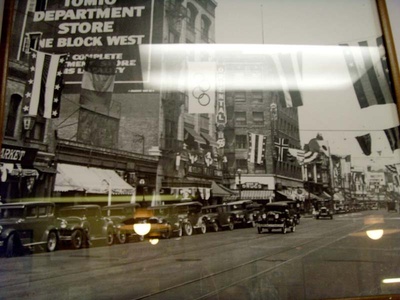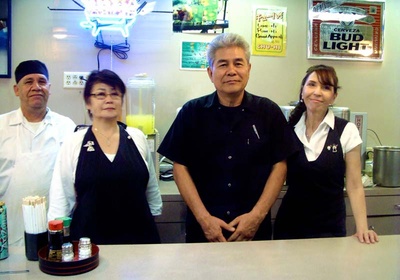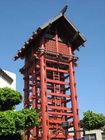Mamoru Hanamura sips his tall water glass full of hot, red tea, exhales slowly and says, “They used to teach me so many things. When I had a problem, I always had somebody.” Speaking of past friends, mentors and fellow members of the Issei generation, his gaze shifts towards the window that faces out onto First street as he mentions that many of his past customers and neighbors have passed away now. Yet Hanamura remains optimistic. After 34 years running the Mitsuru Grill, he can now be the one giving advice and support to his fellow Little Tokyo business owners.
Upon first glance, Mitsuru Grill, located at 316 First Street, appears clean, cozy and inviting. Upon further investigation though, it is so much more. The restaurant serves as a kind of collective memory bank for the neighborhood. Lining the walls of Mitsuru Grill are photographs ranging from the turn of the century to the present day. There is a photo of a family at Manzanar, of which Hanamura says simply, “It has a good story and a bad story.” Also there is a photo of children working in a strawberry field that once existed right across First Street, and a photo depicting the corner of First and San Pedro, most likely taken around the 1930s.
On the opposite wall, there is a series of digital color photos hung minimally and elegantly in black frames ranging from small to large. Hanamura explains that these are the photos of a local photographer who recently passed away. The artwork, hung in her honor by her husband, serves as a simultaneous nod to a friend as well as to her role as a local artist. The photographs feature the faces of neighbors and local business owners, and showcase a past parade down First Street.
In addition to the fascinating historical artwork, Mitsuru Grill serves delicious food, known for its genre of American and Japanese fusion. Hanamura explains that his favorite thing to make is still sushi, or fish with vegetables, but for the last three decades he has put Mitsuru Grill on the map by creating special fusion dishes that incorporate multicultural elements. There is a corned beef and cabbage dish with a Japanese spin and a BBQ eel salad. In another twist on the classic Japanese restaurant, there are two menus, one with more traditional Japanese food and sushi, and one with American favorites such as tuna melts, ham and eggs, and liver and onions.
In a newspaper article about Mitsuru Grill from a few years ago, the writer describes the setting as “Twilight Zone.” He recommends the “Wiener omelet, tuna teriyaki and BLT” as a sampling of the unusual and intriguing options the restaurant has to offer. Perhaps this fusion is due to the changing ethnic landscape of the neighborhood. Hanamura recalls a time when the area was predominantly Japanese people. Though now he says it is very diverse, and with a small laugh, even to the point where calling it “Little Tokyo” is a bit of a misnomer. He notes that people from different backgrounds are cooking food of all different cultures, a practice only recently accepted by the neighborhood.
Mitsuru Grill is also famous for its large sushi platters, which can be ordered in advance for celebrations such as New Years. Hanamura brings out a photo album of pictures of these platters and explains that each one is like a work of art, in that it takes time to prepare and arrange for each customer. The days surrounding big holidays are an extremely busy time for Mitsuru Grill and Hanamura says that he and his staff often stay up all night the eve before a large order is needed.
My fellow interviewer and I stay for lunch and order a bowl of ramen each, as well as a 12-piece plate of sushi. Everything is delicious, and we leisurely enjoy our lunchtime smorgasbord. We notice we are the only ones in the restaurant at this time, though. Hanamura explains with frustration that offices often no longer have a designated “lunch hour,” and he is absolutely right. People now sit and eat at their desks, or have only a few minutes to pick something up and they are too busy to stop and enjoy a real meal at a restaurant like Mitsuru Grill. In an effort to keep up with the times, Hanamura has altered his lunch menu in order to make it rush-friendly, but still, people have less and less time as the years progress. While business is still as good as it always has been overall, the hours of service have changed quite a bit since the restaurant’s inception.
Lastly, Hanamura tells us about his family. Around the time when the dollar to yen ratio changed, Japanese people started moving away from Little Tokyo and into the surrounding suburbs. Hanamura lives in Chino Hills, a predominantly Chinese neighborhood about 30 minutes from downtown Los Angeles. He continues by explaining that almost all of the local business owners in Little Tokyo no longer live in the area. Most live in suburbs like his, outside the hubbub of downtown LA. He has two teenage. daughters, one of whom he is teaching to cook. Every weekend Hanamura teaches his daughter how to make Japanese and American food, and his daughter then practices by cooking for her friends. He tells us this with a smile on his face, but when asked if she will work at Mitsuru Grill, Hanamura says she is busy applying to colleges now.
Mitsuru Grill serves as a fascinating example of the way in which the neighborhood of Little Tokyo has evolved from its homogenous beginnings into the multicultural center it is today. Mamoru Hanamura’s Japanese/American fusion cuisine operates as a metaphor for the fusing of cultures over time, and the intriguingly delicious flavors it produces.
** Discover Nikkei partnered with Professor Morgan Pitelka of Occidental College and his students taking the Spring 2010 seminar “Japanophilia: Orientalism, Nationalism, Transnationalism” on a meaningful community-based documentation project. The students interviewed owners of five long-time Little Tokyo businesses to create Nikkei Albums and articles.
View the Nikkei Album collection: Mitsuru Grill
© 2010 Stephanie Varela





